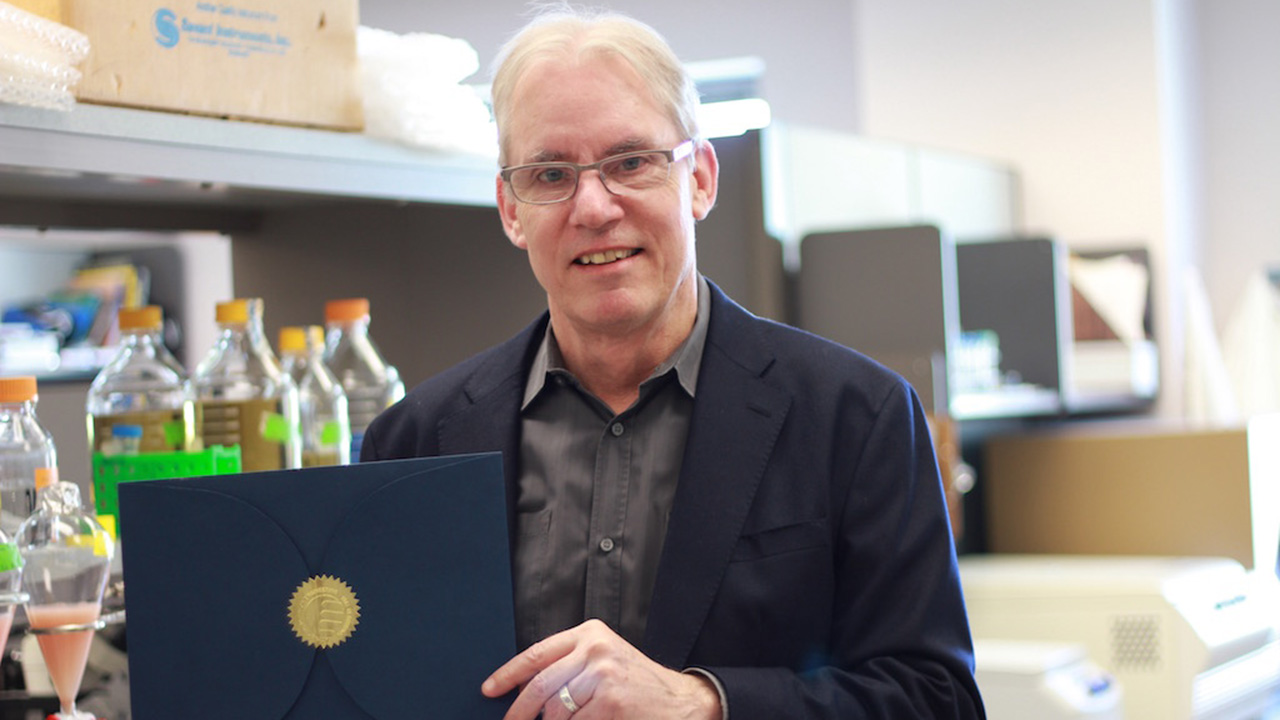In distinguished company
It was a workday like any other. Dr. Stuart Foster, a senior scientist at Sunnybrook Research Institute (SRI), walked into his office with its picturesque view overlooking midtown Toronto. Unlike typical days at the lab, however, he found a FedEx box sitting on his desk. He wasn’t expecting a delivery and wondered what was inside.
“I opened it, and the first thing I saw was something that looked pretty official,” says Foster, holding up a navy blue envelope with a gold seal. That envelope contained exciting news: he had been elected to the U.S. National Academy of Engineering (NAE) as a foreign member.
The NAE, part of the National Academies of Sciences, Engineering and Medicine, has 2,530 U.S. and foreign members who are among the world’s most accomplished engineers. Only 21 engineers in Canada have ever been accorded this distinction.
Election to the NAE puts Foster in the same company as engineers that he admires greatly. These include James Fujimoto, the father of optical coherence tomography, an imaging technique that’s used to diagnose medical conditions, and Albert Macovski, whose innovations in X-ray, ultrasound, MRI and CT made these technologies work better and become more cost-effective. Internet mogul Larry Page, who co-founded Google, and Robert Langer, a trailblazer in tissue engineering and drug delivery systems, are also members.
Candidates are nominated and elected to the NAE by current members—completely in secret. Foster was unaware that he was even being considered for membership until he received the package from the NAE. He later found out that his nomination had been initiated by professor Matthew O’Donnell, emeritus dean of engineering at the University of Washington.
While the process surrounding his election to the prestigious organization remains somewhat of a mystery, the rationale for his inclusion is much clearer. Foster, who holds the Canada Research Chair in Ultrasound Imaging, pioneered micro-ultrasound, an imaging technique done at high frequencies to produce high-resolution images. The technology enables minute structures within tissue, and physiological details, like blood flowing into a mouse tumour, for example, to be seen without using invasive probes.
Demand for the technology was so great that in 1999 Foster formed a company, VisualSonics, to commercialize it. The company was acquired in 2010 by SonoSite and bought a year later by Fujifilm. VisualSonics scanners can be found at universities, research institutes and drug companies worldwide. Through Foster’s innovation, researchers have been able to test more drugs and investigate more disease models by studying the effects, over time, of knocking out or adding genes in preclinical models. It does all of this noninvasively.
“Now it’s turned another corner and it’s going into the clinic. We’re excited about that,” says Foster, of the technology, which received FDA approval in 2016 and Health Canada approval in early 2017. The company is exploring applications in areas that include neonatal imaging, neurosurgical guidance and prostate imaging.
His work addresses one of the NAE’s 14 Grand Challenges: to engineer the tools of discovery. “Stuart’s research underscores just how important discovery science is. Across more than three decades, he has painstakingly pursued the realization of ideas that have had material and meaningful impact,” says Dr. Michael Julius, vice-president, research, Sunnybrook Health Sciences Centre and Sunnybrook Research Institute. “He is much deserving of the ‘flowers’ this award bestows.”
Reflecting on his career, Foster says he is privileged to have had the opportunity to investigate ideas and directions that were limited only by his imagination. When asked how he feels about joining the ranks of such esteemed engineers, he says, “It’s amazing. That’s the short answer. It’s a humbling experience to think that the work we’ve done has been recognized to that extent.”



